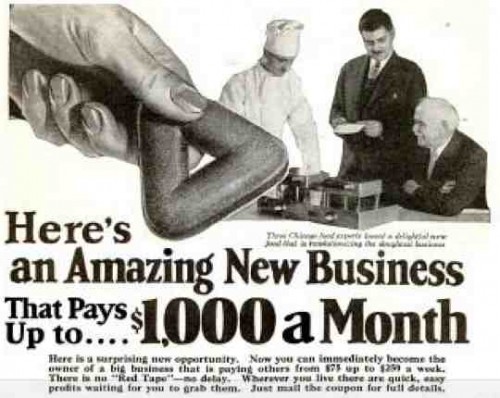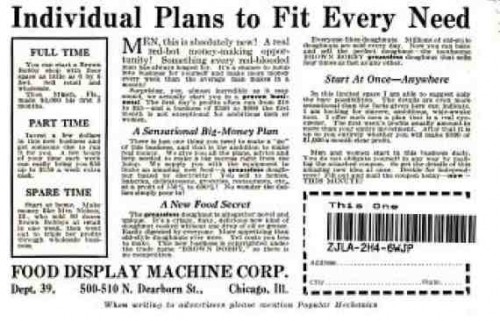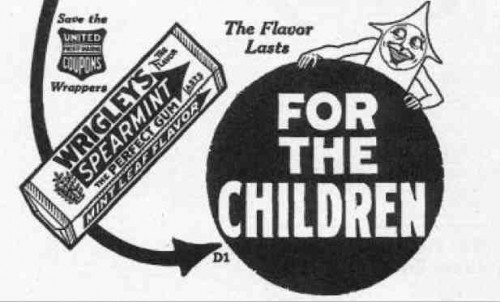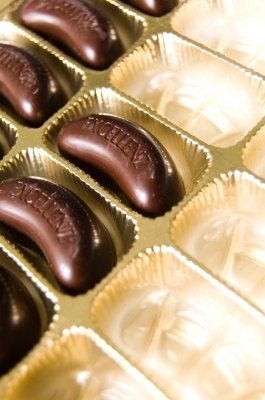Junk Food
Brown Bobby


Get rich quick with triangular donuts!
Explanation here.
Original ad here.
Posted By: Paul - Thu Nov 03, 2011 -
Comments (5)
Category: Business, Advertising, Products, Technology, Junk Food, Appliances, 1930s
Follies of the Mad Men #163

I cannot believe that even in the 1920s, this Wrigley's mascot was anything less than a source of nightmares to children everywhere.
Posted By: Paul - Sat Oct 15, 2011 -
Comments (6)
Category: Business, Advertising, Products, Children, Junk Food, 1920s
Follies of the Mad Men #162
Does not contain corn likker. No hillbilly beard necessary to enjoy.
Yes, we're hip. That's why we choose "Makin' Whoopee" from 1928 as our theme tune.
Contains no psychedelics, despite producing visions of talking pitcher.
Posted By: Paul - Sun Oct 02, 2011 -
Comments (6)
Category: Business, Advertising, Products, Drugs, Psychedelic, Junk Food, 1950s, 1960s
Follies of the Mad Men #154
Four decades of commercials for the medicinal tasting soda. Which one would convince you to drink it?
Posted By: Paul - Fri Aug 05, 2011 -
Comments (6)
Category: Business, Advertising, Products, Junk Food, 1960s, 1970s, 1980s, 1990s
Follies of the Mad Men #144
Imagine living a life where your major existential dilemma was which flavor snack cake to purchase.
I was going to assume that Ho Hos were no longer made, given the nasty use of "ho" as a pejorative--but apparently they are still around.
Posted By: Paul - Mon Jun 13, 2011 -
Comments (3)
Category: Business, Advertising, Products, Food, Junk Food, 1970s
Swallow
Go here to see a video about a professional eater of odd objects.
Posted By: Paul - Mon Jan 31, 2011 -
Comments (1)
Category: Body Modifications, Medicine, Performance Art, Books, Junk Food
Another Helping of Food Related Weirdness – 7

Meanwhile, here is someone who is taking the chocolate maker’s art way too literally. Jean Zaun of Fredericksburg in Pennsylvania uses a mixture of dark and white chocolate, food colouring and confectioner’s glaze to recreate famous works of art, including the frames, in a deliciously edible form. Her subjects have included the works of Van Gogh, Munch and Da Vinci, as well as a portrait of Ozzy Osborne commissioned by his wife. While the chocolate artworks are edible, Zaun believes they should be souvenirs rather than snacks. “They are meant to be consumed by the eye, not the stomach.” Zaun Explained (Daily Mail).
And the misuse of materials won’t stop there, at least not if Dr. Peter Eisner of the Fraunhofer Institute gets his way. Concerned that meat consumption is both unhealthy and bad for the environment, Dr. Eisner has started looking for ways to supplement or replace animal products with vegetable equivalents. His first success is a milk substitute derived from lupins that can even be used to make cheese, meanwhile co-worker Daniela Sussmann has extracted a protein from the seeds gives low-fat sausages more of the sensation of their unadulterated competition. Eisner reckons that our ever growing appetite for meat could one day be disastrous, arguing that the resources needed to produce 1 kilo of meat could instead yield 80 to 100 kilos of fruit or vegetables (Softpedia).
More in extended >>
Posted By: Dumbfounded - Mon Jan 10, 2011 -
Comments (7)
Category: Agriculture, Animals, Farming, Art, Food, Bacon, Candy, Junk Food, Nutrition, Vegetables
Now That’s Sushi
Sorry for posting another video from the same people so soon, but I couldn't resist. I can understand how a bird in a bird in a bird in a bird in a bird in a pig might not be appetizing to many people, but I think everyone can enjoy this video. It answers the age old question, "What if I made Sushi with bacon instead of seaweed?" Enjoy.
Posted By: Salamander Sam - Tue Dec 07, 2010 -
Comments (7)
Category: Food, Bacon, Junk Food, Video, Eating

| Who We Are |
|---|
| Alex Boese Alex is the creator and curator of the Museum of Hoaxes. He's also the author of various weird, non-fiction, science-themed books such as Elephants on Acid and Psychedelic Apes. Paul Di Filippo Paul has been paid to put weird ideas into fictional form for over thirty years, in his career as a noted science fiction writer. He has recently begun blogging on many curious topics with three fellow writers at The Inferior 4+1. Contact Us |




